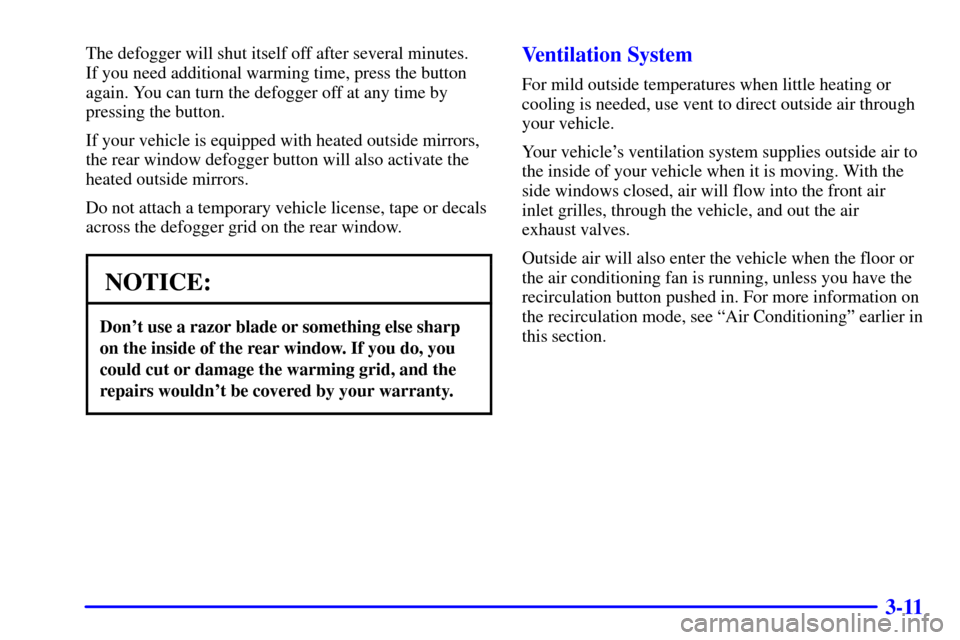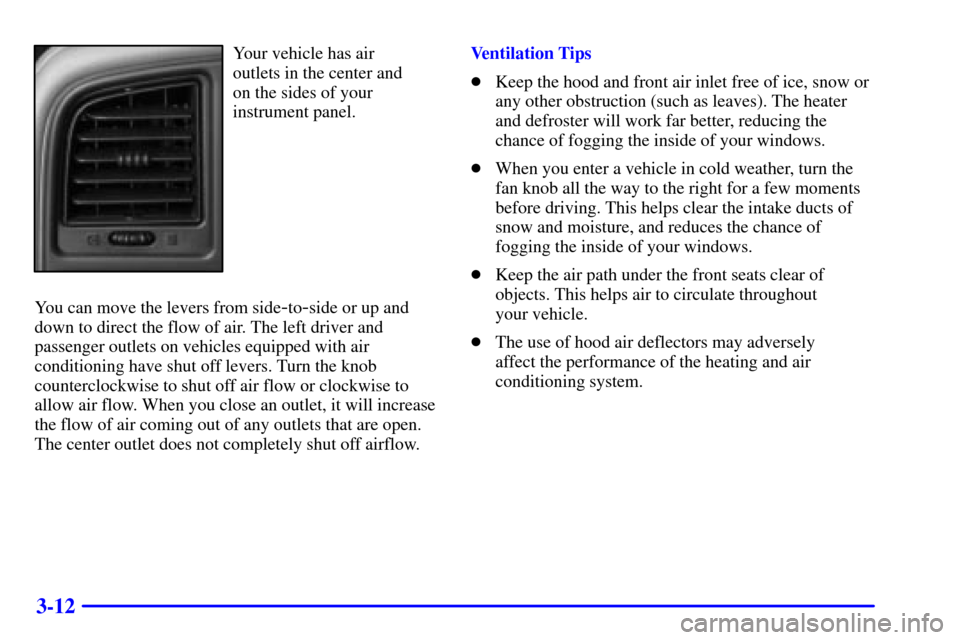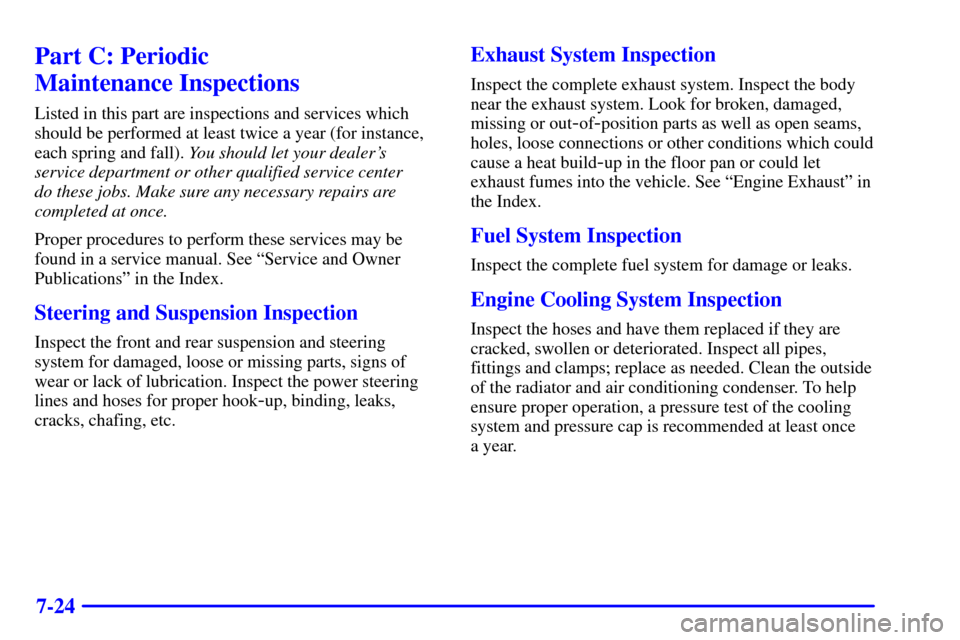Page 213 of 497

3-11
The defogger will shut itself off after several minutes.
If you need additional warming time, press the button
again. You can turn the defogger off at any time by
pressing the button.
If your vehicle is equipped with heated outside mirrors,
the rear window defogger button will also activate the
heated outside mirrors.
Do not attach a temporary vehicle license, tape or decals
across the defogger grid on the rear window.
NOTICE:
Don't use a razor blade or something else sharp
on the inside of the rear window. If you do, you
could cut or damage the warming grid, and the
repairs wouldn't be covered by your warranty.
Ventilation System
For mild outside temperatures when little heating or
cooling is needed, use vent to direct outside air through
your vehicle.
Your vehicle's ventilation system supplies outside air to
the inside of your vehicle when it is moving. With the
side windows closed, air will flow into the front air
inlet grilles, through the vehicle, and out the air
exhaust valves.
Outside air will also enter the vehicle when the floor or
the air conditioning fan is running, unless you have the
recirculation button pushed in. For more information on
the recirculation mode, see ªAir Conditioningº earlier in
this section.
Page 214 of 497

3-12
Your vehicle has air
outlets in the center and
on the sides of your
instrument panel.
You can move the levers from side
-to-side or up and
down to direct the flow of air. The left driver and
passenger outlets on vehicles equipped with air
conditioning have shut off levers. Turn the knob
counterclockwise to shut off air flow or clockwise to
allow air flow. When you close an outlet, it will increase
the flow of air coming out of any outlets that are open.
The center outlet does not completely shut off airflow.Ventilation Tips
�Keep the hood and front air inlet free of ice, snow or
any other obstruction (such as leaves). The heater
and defroster will work far better, reducing the
chance of fogging the inside of your windows.
�When you enter a vehicle in cold weather, turn the
fan knob all the way to the right for a few moments
before driving. This helps clear the intake ducts of
snow and moisture, and reduces the chance of
fogging the inside of your windows.
�Keep the air path under the front seats clear of
objects. This helps air to circulate throughout
your vehicle.
�The use of hood air deflectors may adversely
affect the performance of the heating and air
conditioning system.
Page 449 of 497

6-84
Fuse Usage
B/U LP Backup Lamps, Automatic
Transmission Shift Lock
Control System
ATC Automatic Transfer Case
RR DEFOG Rear Window Defogger,
Heated Mirrors (Relay)
RR PRK Right Rear Parking Lamps
ECM B PCM
F/PMP Fuel Pump (Relay)
O2 A Oxygen Sensors
FUEL HT Fuel Heater, Glow Plug and Intake
Heater Controls
O2 B Oxygen Sensors
LR PRK Left Rear Parking Lamps
RR DEFOG Rear Window Defogger,
Heated Mirrors
HDLP Headlamps (Relay)
TRL PRK Parking Lamps Trailer Wiring
RT HDLP Right Headlamps
DRL Daytime Running Lamps (Relay)
HTD MIR Heated MirrorsFuse Usage
LT HDLP Left Headlamps
A/C Air Conditioning
AUX PWR Cigarette Lighter, Auxiliary
Power Outlets
SEO 2 Special Equipment Option Power,
Power Seats, Aux Roof Mnt Lamp
SEO 1 Special Equipment Option Power,
Aux Roof Mnt Lamp, Cell
Phone, OnStar
�
DRL Daytime Running Lamps
A/C A/C (Relay)
FOG LP Fog Lamps
FOG LP Fog Lamps (Relay)
RADIO Audio System, Instrument Cluster,
Climate Control System
CIGAR Cigarette Lighter, Auxiliary
Power Outlets
RT TURN Right Turn Signals
BTSI Automatic Transmission Shift
Lock Control System
LT TURN Left Turn Signals
FR PRK Front Parking Lamps,
Sidemarker Lamps
Page 454 of 497

6-89 Fuel Tank Capacity
Type Quantity
Short Bed 26.0 U.S. gallons (98 L)
Long Bed 34.0 U.S. gallons (128 L)
Chassis Cab
(Pickup
Box Delete)34.0 U.S. gallons (128 L)
Chassis Cab 3500 27.0 U.S. gallons (102 L) (front)
23.0 U.S. gallons (87 L) (rear)
Chassis Cab 3500
(California)24.0 U.S. gallons (90 L) (front)
23.0 U.S. gallons (87 L) (rear)
Chassis Cab 3500 27.0 U.S. gallons (102 L) (front)
Chassis Cab 3500
(California)27.0 U.S. gallons (102 L) (front)
Chassis
Cab 3500HD23.0 U.S. gallons (87 L) (front)
18.0 U.S. gallons (68 L) (rear)
Chassis
Cab 3500HD23.0 U.S. gallons (87 L) (front)
Air Conditioning
Refrigerant Capacity
If you do your own service work, you'll need the proper
service manual. See ªDoing Your Own Service Workº in
the Index for additional information. It is recommended
that service work on your air conditioning system be
performed by a qualified technician.
Air Conditioning
Refrigerant R
-134a 1.76 lbs (0.8 kg). . . . . . . . . . . .
Use Refrigerant Oil, R134a Systems
Page 479 of 497

7-24
Part C: Periodic
Maintenance Inspections
Listed in this part are inspections and services which
should be performed at least twice a year (for instance,
each spring and fall). You should let your dealer's
service department or other qualified service center
do these jobs. Make sure any necessary repairs are
completed at once.
Proper procedures to perform these services may be
found in a service manual. See ªService and Owner
Publicationsº in the Index.
Steering and Suspension Inspection
Inspect the front and rear suspension and steering
system for damaged, loose or missing parts, signs of
wear or lack of lubrication. Inspect the power steering
lines and hoses for proper hook
-up, binding, leaks,
cracks, chafing, etc.
Exhaust System Inspection
Inspect the complete exhaust system. Inspect the body
near the exhaust system. Look for broken, damaged,
missing or out
-of-position parts as well as open seams,
holes, loose connections or other conditions which could
cause a heat build
-up in the floor pan or could let
exhaust fumes into the vehicle. See ªEngine Exhaustº in
the Index.
Fuel System Inspection
Inspect the complete fuel system for damage or leaks.
Engine Cooling System Inspection
Inspect the hoses and have them replaced if they are
cracked, swollen or deteriorated. Inspect all pipes,
fittings and clamps; replace as needed. Clean the outside
of the radiator and air conditioning condenser. To help
ensure proper operation, a pressure test of the cooling
system and pressure cap is recommended at least once
a year.